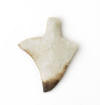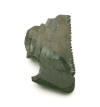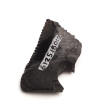

(up-dated31/Jan./2017)
(Photo by Pete Bostrom)
Larry's club, displayed at the Gilcrease Institute, Tulsa, Oklahoma.
"CAHOKIA MOUNDS" SHARK'S TOOTH CLUBSDuring Perino's
excavation of Md 34 at Cahokia, he discovered 4 more flint shark's teeth
(3 with convex

 (Photo
Gilcrease) bases) including this tooth
(Photo
Gilcrease) bases) including this tooth (Photo
Gilcrease) with a stem at the base.
It had been burned and was found in a large pit that had a lot of burned
material in it's fill. The pit has been interpreted as a ceremonial
feasting refuse pit.. In 2002, a burned great white shark's tooth was
found in Perino's back dirt during re-excavations at Mound 34.
(Photo
Gilcrease) with a stem at the base.
It had been burned and was found in a large pit that had a lot of burned
material in it's fill. The pit has been interpreted as a ceremonial
feasting refuse pit.. In 2002, a burned great white shark's tooth was
found in Perino's back dirt during re-excavations at Mound 34.
Many of the photos of the original shark's teeth, both real and chert, on this page were taken by Larry during visits to the Gilcrease Institute, in Tulsa, Ok. Larry wishes to thank the Gilcrease Institute for their kindness in allowing him to show these pictures on this forum.
These are the
original shark's teeth from the club (upper row and 2 on bottom right).
The other teeth were found in Md. 34 at Cahokia. They are now curated at
the Gilcrease Institute, Tulsa,Ok.
![]() (Photo
LK Click to enlarge)
(Photo
LK Click to enlarge)
The original shark's teeth were drilled like this , then tied to the club.
These are photos of the 5 original great white shark's teeth from the club. The 5 on the bottom had been drilled like the one on top but their dentin has decayed, removing much of the original drilled holes.

 (Photo
Gilcrease)
These are pictures of a burned great white shark's tooth from Md 34,
probably found in the fill of the large burned pit, described by
Perino.
(Photo
Gilcrease)
These are pictures of a burned great white shark's tooth from Md 34,
probably found in the fill of the large burned pit, described by
Perino.
Here's the original teeth laid out in the way they might have been on the original club.
Above is Pete Bostrom's photo of one of Larry's first replicas.



 (Photos by Gilcrease Institute, Tulsa Ok.)
(Photos by Gilcrease Institute, Tulsa Ok.)
Here are close-ups of the 8 original club teeth.
Above are two shark's teeth from Greg Perdun's collection. The larger one is from Southern Missouri and the other is from the Cahokia Mounds area
Larry demonstrates
the use of the shark's tooth
club. This is a replica of one found by
Perino between Monk's Mound and Mound 34 at Cahokia.
Installing the teeth
(Photos LK)
Cutting the grooves for the teeth. Larry has found that it is a good
idea to pre-cut all of the grooves on one side, then install the teeth
on that side, before continuing to the other side. The reason for
doing this is to attempt to prevent cutting his knuckles as they brush
against the installed teeth. Notice that the tooth in the end is
already installed and the glue has set up.
(Photos LK) Here, the last 2
teeth, on the first side, are ready to be set into position. Larry
uses hide glue, mixed with charcoal, for the adhesive.
(Photo LK)
All the teeth on the first side are now set.
Larry only got cut on one knuckle when he brushed it against the tooth
on the end. That happened while chiseling the grooves. The glue is
left to dry, for a minimum of 24 hours, before the club is turned over
and the opposite side's teeth are installed.
(Photos LK)
Here, the second side is completed and the
handle is being painted with extra virgin olive oil because it
penetrates so well. The rest of the handle needs painting and the club
is done.
(Photos LK)
The finished club. This one will be raffled
off to raise money for the Powell Archaeological Research Center. The
club is 57 1/2 cm. (22 5/8 inches) long, from the end of the
handle to the tip of the shark's tooth, and 17 cm. (6 5/8 inches)
wide, at it's widest point. This is the eighth club Larry has made.